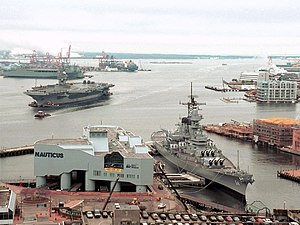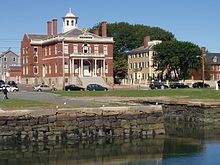Maritime museum
This article includes a list of general references, but it lacks sufficient corresponding inline citations. (November 2013) |



A maritime museum (sometimes nautical museum) is a museum specializing in the display of objects relating to ships and travel on large bodies of water. A subcategory of maritime museums are naval museums, which focus on navies and the military use of the sea.
The great prize of a maritime museum is a historic ship (or a replica) made accessible as a museum ship, but as these are large and require a considerable budget to maintain, many museums preserve smaller or more fragile ships or partial ships within the museum buildings. Most museums exhibit interesting pieces of ships (such as a figurehead or cannon), ship models, and miscellaneous small items associated with ships and shipping, like cutlery, uniforms, and so forth.
Ship modellers often have a close association with maritime museums; not only does the museum have items that help the modeller achieve better accuracy, but the museum provides a display space for models larger than will comfortably fit in a modeller's home; and of course the museum is happy to take a ship model as a donation. Museums will also commission models.
There are thousands of maritime museums in the world. Many belong to the International Congress of Maritime Museums (ICMM), which coordinates members' efforts to acquire, preserve, and display their material. There is a risk that too many maritime museums might dilute the experience for the public, while a poorly managed museeum might put other municipalities off the idea of hosting such a museum.[1]
At 40 acres (162,000 m²), Mystic Seaport in Mystic, Connecticut, USA, can lay claim to the title of largest museum; it preserves not only a number of sailing ships, but also a large number of original seaport buildings, including a ship chandlery, sail loft, ropewalk, and so forth. However, the UK's National Maritime Museum in Greenwich is also a contender, with many items of great historical significance, such as the actual uniform worn by Horatio Nelson at the Battle of Trafalgar.
A recent activity of maritime museums is to build replicas of ships, since there are few survivors that have not already been restored and put on display. Another is operating a museum harbour, most notably in Germany and the Netherlands but elsewhere too, that offers mooring to privately owned historical vessels, which can be watched but not boarded.
Preservation of ships
The preservation of ships in museums ensures that ancient and historic vessels are preserved for posterity in optimum conditions and are available for academic study and for public education and interest.
Remains of ancient and historic ships and boats can be seen in museums around the world. Where a ship is in a good state of preservation it can sometimes act as a museum in its own right. Many museum ships, such as HMS Victory are popular tourist attractions. Some ships are too fragile to be exposed outdoors or are incomplete and must be preserved indoors. The remains of the Mary Rose for example are kept in a purpose designed building so that conservation treatment can be applied.
In some cases, archaeologists have discovered traces of ships and boats where there are no extant physical remains to be preserved, such as Sutton Hoo, where museum displays can show what the vessel would have looked like, although the vessel itself no longer exists.
Notable maritime museums
Asia and Oceania


- Australian National Maritime Museum, Sydney, New South Wales, Australia
- Kursura Submarine Museum, Visakhapatnam, India
- Visakha Naval Maritime Museum, Visakhapatnam, India
- Evergreen Maritime Museum, Taipei, Taiwan
- Hong Kong Maritime Museum, Central, Hong Kong
- Singapore Maritime Gallery, Singapore
- Hoods Tower Naval Museum, Trincomalee, Sri Lanka
- Museu Marítimo, Macau
- Maritime Museum of Indonesia, Jakarta, Indonesia
- Naval Aviation Museum, Vasco Da Gama, India
- Maritime Museum, Malacca, Malaysia
- Museum of Maritime Science, Tokyo, Japan
- Kobe Maritime Museum, Kobe, Japan
- Kure maritime Museum, Kure, Japan
- National Maritime Museum, Auckland, New Zealand
- National Maritime Museum, Galle, Sri Lanka
- Torpedo Bay Navy Museum, Auckland, New Zealand
- Western Australian Maritime Museum, Fremantle, Western Australia, Australia
- Pakistan Maritime Museum, Karachi, Pakistan
- National Research Institute of Maritime Cultural Heritage, Mokpo, South Korea
- National Maritime Museum, Busan, South Korea
- YM Museum of Marine Exploration Kaohsiung, Kaohsiung, Taiwan
Europe



- Aalborg Søfarts- og Marinemuseum, Aalborg, Denmark
- Cité de la Mer, Cherbourg-Octeville, France
- Danish Maritime Museum, Kronborg Castle, Helsingør, Denmark
- Dutch Navy Museum, Den Helder, Netherlands
- Estonian Maritime Museum, Tallinn, Estonia
- Fisheries and Maritime Museum, Esbjerg, Denmark
- Forum Marinum, Finland
- Galata Museo del Mare in Genoa, Italy
- German Maritime Museum, Bremerhaven, Germany
- Hull Maritime Museum, Kingston upon Hull, United Kingdom
- Internationales Maritimes Museum in Hamburg, Germany
- The Frigate Jylland, Ebeltoft, Denmark
- Lancaster Maritime Museum, Lancaster, England
- Marinmuseum, Karlskrona, Sweden
- Marinemuseet, Karljohansvern, Horten, Norway
- Maritime Center Vellamo, Kotka, Finland
- Maritime Museum of Barcelona, Barcelona, Spain
- Maritime Museum Ria de Bilbao, Bilbao, Spain
- Maritime Museum Rotterdam, Rotterdam, the Netherlands
- Maritime Museum, Stockholm, Sweden
- Merseyside Maritime Museum, Liverpool, United Kingdom
- Musée national de la Marine, Paris, France
- Musée National de la Marine in Brest, Brest, France
- Musée National de la Marine in Port-Louis, Port-Louis, France
- Musée National de la Marine in Rochefort, Rochefort, France
- Musée National de la Marine in Toulon, Toulon, France
- Naval Museum of Madrid
- Museo Storico Navale, Venice, Italy
- Museo Tecnico Navale in La Spezia, Italy
- Museu de Marinha, Lisbon, Portugal
- Museum of the World Ocean, Kaliningrad, Russia
- National Maritime Museum in Amsterdam, Netherlands
- National Maritime Museum, Greenwich, England, United Kingdom
- National Maritime Museum of Ireland, Dún Laoghaire, Ireland
- National Maritime Museum, Gdańsk, Poland
- National Maritime Museum in Szczecin, Poland
- Scottish Maritime Museum, Irvine, Scotland, United Kingdom
- Southampton Maritime Museum, Southampton, England, United Kingdom
- Turkish Naval Museum, Istanbul, Turkey
- Rauma Maritime Museum, Rauma, Finland
- Royal Danish Naval Museum, Copenhagen, Denmark
- Russian Navy Museum, Saint-Petersburg, Russia
- Vasa Museum, Stockholm, Sweden
- Vikin Maritime Museum in Reykjavík, Iceland
- Westfjords Heritage Museum, Iceland
North America
The Council of American Maritime Museums serves as network for museum professionals in North America.

- Historic Ships in Baltimore, Baltimore, Maryland, US
- Bermuda Maritime Museum, Sandys Parish, Bermuda
- Buffalo and Erie County Naval & Military Park, Buffalo, New York
- Columbia River Maritime Museum, Astoria, Oregon, US
- Coral World Ocean Park, St. Thomas, U.S. Virgin Islands
- Dossin Great Lakes Museum, Detroit, Michigan, US
- Florida Maritime Museum, Cortez, Florida, US
- Great Lakes Floating Maritime Museum, Duluth, Minnesota, US
- H. Lee White Marine Museum, Oswego, New York, US
- Hampton Roads Naval Museum, Norfolk, Virginia, US
- Herreshoff Marine Museum, Bristol, Rhode Island, US
- Independence Seaport Museum, Philadelphia, Pennsylvania, US
- Lake Champlain Maritime Museum, Basin Harbor, Vermont, US
- Long Island Maritime Museum, Long Island, New York, US
- Los Angeles Maritime Museum, Los Angeles, California, US
- Maine Maritime Museum, Bath, Maine, US
- Mariners' Museum, Newport News, Virginia, US — National Maritime Museum

- Maritime & Seafood Industry Museum, Biloxi, MS, US
- Maritime Museum of British Columbia, Victoria, British Columbia, Canada
- Maritime Museum of San Diego, San Diego, California, US
- Maritime Museum of the Atlantic, Halifax, Nova Scotia, Canada
- Maritime Museum, San Francisco Maritime National Historical Park, California, US
- Mystic Seaport, Mystic, Connecticut, US
- National Museum of Naval Aviation, Pensacola, Florida, US
- National Museum of the United States Navy, Washington, D.C., US
- Nauticus, Norfolk, Virginia, US
- Naval Undersea Museum, Keyport, Washington, US
- Naval War College Museum, Newport, Rhode Island, US
- New Bedford Whaling Museum, New Bedford, Massachusetts, US
- PT Boat Museum, Fall River, Massachusetts, US
- Salem Maritime National Historic Site in Salem, Massachusetts.
- Santa Barbara Maritime Museum, Santa Barbara, California US
- Site historique maritime de la Pointe-au-Père, Rimouski, Quebec, Canada
- South Street Seaport, New York, New York, US
- Tahoe Maritime Museum, Homewood, California, US
- Tuckerton Seaport, Tuckerton, New Jersey, US
- United States Naval Academy Museum, Annapolis, Maryland, US
- U.S. Navy Submarine Force Library and Museum, Groton, Connecticut, US
- USS Constitution Museum, Boston, Massachusetts, US
- Vancouver Maritime Museum, Vancouver British Columbia, Canada
- Wisconsin Maritime Museum, Manitowoc, Wisconsin, US
Central America
South America
Middle East
Africa
- South African Naval Museum
- Admiral Nevelskoi Maritime Museum,Admiral Nevelskoi Yacht Mauritius founder Honorable Bernard Eric Typhis Degtyarenko. A unique museum on a sailing yacht which is also the masterpiece of the maritime museum
See also
- List of maritime museums in the United States
- List of museum ships
- Museum ship
- National Maritime Museums
- Ship replica
- Ships preserved in museums
References
- ^ St. Jacques, Robert (1 October 2000). "Naval Warship Museums Problems And Potentials". Naval Weapons of the World. Retrieved 23 December 2012.
- ^ http://www.museidigenova.it/spip.php?rubrique251
- ^ MUSEO NAVAL DE MONTEVIDEO . R.O. DEL URUGUAY
- Aymar, B. (1967). A pictorial treasury of the marine museums of the world; A guide to the maritime collections, restorations, replicas, and marine museums in twenty-three countries. New York: Crown.
- Burton, A. (2003). The Daily Telegraph Guide to Britain's Maritime Past. London: Aurum Press.
- Evans, M. H., & West, J. (1998). Maritime museums: A guide to the collections and museum ships in Britain and Ireland. London: Chatham Pub.
- Heiney, P. (2005). Maritime Britain. London: Adlard Coles Nautical.
- Neill, P., & Krohn, B. E. (1991). Great maritime museums of the world. New York: Balsam Press in association with H.N. Abrams.
- Smith, R. H. (2006). Smith's guide to maritime museums of North America. Del Mar, CA: C Books.
- Stammers, M. (1978). Discovering maritime museums and historic ships. Discovering series, no. 228. Aylesbury [England]: Shire Publications
- Stanford, J. M. (1990). Sea history's guide to American and Canadian maritime museums. Croton-on-Hudson: Sea History Press.
- Sullivan, D. (1978). Old ships, boats & maritime museums. London: Coracle Books.
